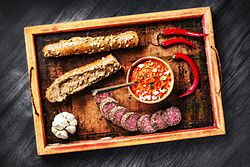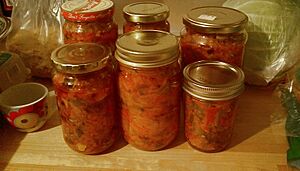Ajvar facts for kids

Ajvar with bread, garlic, pepper and salami
|
|
| Region or state | Balkans |
|---|---|
| Main ingredients | Capsicum (bell peppers), oil, salt |
Ajvar (pronounced like "EYE-var") is a tasty spread or side dish. It's mostly made from sweet bell peppers and sometimes eggplant. Think of it like a relish or a thick sauce.
This delicious food became very popular in Southeast Europe, especially in the Balkans, after World War II. You'll find it in many homes and restaurants there.
Homemade ajvar is usually made from roasted peppers. It can be sweet, a little spicy (which is common), or very hot. This depends on the type of peppers used and if chili peppers are added. You can enjoy ajvar as a bread spread or as a side dish with your meals.
There are different kinds of ajvar. Some versions include tomatoes and eggplant. Others are made with green bell peppers and a herb called oregano.
Some special types of ajvar, like "Homemade Leskovac Ajvar" and "Macedonian Ajvar," have their names protected. This means they are recognized for their unique quality.
What is the History of Ajvar?
The name ajvar comes from the Turkish word havyar. This word means "salted roe" or "caviar". It shares its origin with the word "caviar" itself, which comes from the Persian word "xaviyar".
Before the 1900s, a lot of caviar was produced near the Danube River. Sturgeon fish would swim from the Black Sea all the way to Belgrade. "Domestic ajvar," meaning "caviar," was a very popular dish in Belgrade homes and restaurants.
However, around the 1890s, it became harder to get local caviar. So, restaurants in Belgrade started offering a special pepper salad instead. They called it "red ajvar" (crveni ajvar) or "Serbian ajvar" (srpski ajvar). This is how the name ajvar came to be used for the pepper spread we know today.
How is Ajvar Made?
Making ajvar at home involves roasting, mincing, and then cooking peppers. Some factories use fresh minced peppers cooked with sunflower oil, but this can make the quality lower. Making ajvar is quite a bit of work, especially peeling the roasted peppers by hand.
Traditionally, people make ajvar in mid-autumn. This is when bell peppers are most plentiful. They preserve it in glass jars to eat throughout the year. Often, families or neighbors gather together to prepare the peppers. The main type of pepper used is called roga. These peppers are large, red, and shaped like a horn. They have thick flesh and are easy to peel. They usually ripen in late September.
To make ajvar, bell peppers are roasted whole. This can be done over an open fire, on a wood stove, or in an oven. After baking, the peppers need to cool down briefly. This helps the skin separate from the flesh. Next, the skin is carefully peeled off, and the seeds are removed.
The peeled peppers are then ground in a mill or chopped into very small pieces. If they are chopped, it's sometimes called pindjur. Finally, this pepper mixture is cooked for several hours in large pots. Sunflower oil is added to make it thicker, reduce the water, and help it last longer. Salt (and sometimes vinegar) is added at the end. The hot ajvar is then poured directly into clean glass jars and sealed right away.
Where is Ajvar Produced?
Ajvar is made in many countries in the Balkans. These include Bosnia, Croatia, North Macedonia, Albania, Slovenia, and Serbia. Serbia alone produces about 640 tons of ajvar each year!
Ajvar is one of the foods known as zimnica (pronounced "ZIM-nee-tsa"). This word means "winter foods." Zimnica includes things like pickled chili peppers and pickled tomatoes. These are all foods that can be preserved in jars to be enjoyed during the colder months.
See also
 In Spanish: Ajvar para niños
In Spanish: Ajvar para niños



